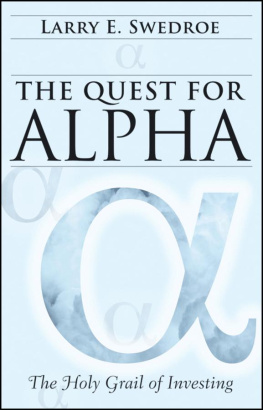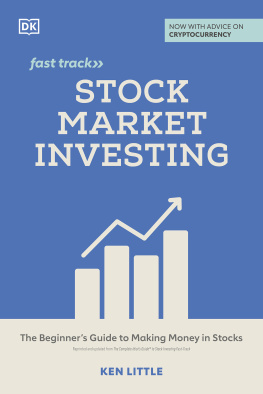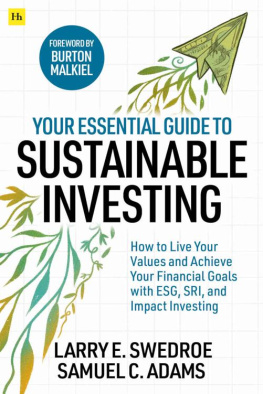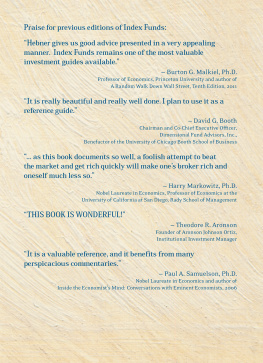Contents

Copyright 2011 by Larry E. Swedroe. All rights reserved.
Published by John Wiley & Sons, Inc., Hoboken, New Jersey.
Published simultaneously in Canada.
No part of this publication may be reproduced, stored in a retrieval system, or transmitted in any form or by any means, electronic, mechanical, photocopying, recording, scanning, or otherwise, except as permitted under Section 107 or 108 of the 1976 United States Copyright Act, without either the prior written permission of the Publisher, or authorization through payment of the appropriate per-copy fee to the Copyright Clearance Center, Inc., 222 Rosewood Drive, Danvers, MA 01923, (978) 750-8400, fax (978) 646-8600, or on the web at www.copyright.com . Requests to the Publisher for permission should be addressed to the Permissions Department, John Wiley & Sons, Inc., 111 River Street, Hoboken, NJ 07030, (201) 748-6011, fax (201) 748-6008, or online at www.wiley.com/go/permissions .
Limit of Liability/Disclaimer of Warranty: While the publisher and author have used their best efforts in preparing this book, they make no representations or warranties with respect to the accuracy or completeness of the contents of this book and specifically disclaim any implied warranties of merchantability or fitness for a particular purpose. No warranty may be created or extended by sales representatives or written sales materials. The advice and strategies contained herein may not be suitable for your situation. You should consult with a professional where appropriate. Neither the publisher nor author shall be liable for any loss of profit or any other commercial damages, including but not limited to special, incidental, consequential, or other damages.
For general information on our other products and services or for technical support, please contact our Customer Care Department within the United States at (800) 762-2974, outside the United States at (317) 572-3993 or fax (317) 572-4002.
Wiley also publishes its books in a variety of electronic formats. Some content that appears in print may not be available in electronic books. For more information about Wiley products, visit our web site at www.wiley.com .
Data in tables in Chapters 3 and 10 used with permission of MSCI. This is the exclusive property of MSCI Inc. (MSCI) and may not be reproduced or redisseminated in any form or used to create any financial products or indices without MSCIs prior written permission. This information is provided as is and none of MSCI, its affiliates or any other person involved in or related to the compilation of this information (collectively, the MSCI Parties) makes any express or implied warranties or representations with respect to the information or the results to be obtained by the use thereof, and the MSCI Parties hereby expressly disclaim all implied warranties (including, without limitation, the implied warranties of merchantability and fitness for a particular purpose) with respect to this information. In no event shall any MSCI Party have any liability of any kind to any person or entity arising from or related to this information.
Data for tables in Chapter 10 used with permission of CRSP. Calculated (or Derived) based on data from CRSP US Stock Database 2010 Center for Research in Security Prices (CRSP), Graduate School of Business, The University of Chicago.
Library of Congress Cataloging-in-Publication Data:
Swedroe, Larry E.
The quest for alpha : the holy grail of investing / Larry E. Swedroe.
p. cm.
Includes bibliographical references and index.
ISBN 978-0-470-92654-3 (cloth); 978-1-118-00569-9 (ebk); 978-1-118-00570-5 (ebk); 978-1-118-00568-2 (ebk)
1. Investments. 2. Investment analysis. 3. Portfolio management. I. Title.
HG4527.S944 2011
332.6dc22
2010034716
This book is dedicated to my three daughters, Jodi Rosen, Jennifer Morris, Jacquelyn Swedroe; my sons-in-law Jay Rosen and Matt Morris; and my three grandchildren, Jonathan, Sophie Rosen, and Ruby Jane Morris. You have all brought great joy to my life.
Acknowledgments
For all their support and encouragement, I would like to thank the principals of The Buckingham Family of Financial Services: Adam Birenbaum, Ernest Clark, Bob Gellman, Ed Goldberg, Mont Levy, Steve Lourie, Vladimir Masek, Bert Schweizer III, and Brenda Witt.
Too many of my coworkers contributed to list them all. However, I would be remiss if I did not mention the special efforts and contributions of RC Balaban, who edits my blog at www.moneywatch.bnet.com and Vladimir Masek, from whom I have learned a great deal about the science of investing. The usual caveat of any errors being my own certainly applies.
I also thank my agent Sam Fleischman for all his efforts over the years and for getting me started as an author. I am forever grateful for his support and friendship.
I especially thank my wife, Mona, the love of my life, for her tremendous encouragement and understanding during the lost weekends and many nights I sat at the computer well into the early morning hours. She has always provided whatever support was neededand then some. Walking through life with her has truly been a gracious experience.
Introduction
The most difficult subjects can be explained to the most slow-witted man if he has not formed any idea of them already; but the simplest thing cannot be made clear to the most intelligent man if he is firmly persuaded that he knows already, without a shadow of a doubt, what is laid before him.
Leo Tolstoy
I am the director of research and a principal of The Buckingham Family of Financial Services. All of us at Buckingham are particularly proud of two things. The first is that we provide a fiduciary standard of care, requiring us to put the interests of our clients ahead of our own. You could say that we eat our own cooking, investing our own personal assets in the same vehicles we recommend to our clients. The second is that our advice is based on the science of investing, or evidence-based investing, not our opinions.
This book presents the evidence from studies published in peer-reviewed academic journals. In addition, you will read the advice of legendary investors such as Benjamin Graham (co-author of Security Analysis ), Peter Lynch (who manged Fidelitys Magellan Fund), and Warren Buffett (CEO of Berkshire Hathaway). And you will be amazed at some of the admissions of industry practitioners and members of the financial media.
The Holy Grail
According to Christian mythology, the Holy Grail was the dish, plate, or cup used by Jesus at the Last Supper, and said to possess miraculous powers. Legend has it that the Grail was sent to Great Britain, where several guardians keep it safe. The search for the Holy Grail is an important part of the legends of King Arthur and his court, with Percival, one of the Knights of the Round Table, and Galahad, Lancelots son, playing the major roles.
The financial equivalent of the quest for the Holy Grail is the quest for the money managers who will deliver alphareturns above the appropriate risk-adjusted benchmark. Our journey together on this quest is really a tale of two competing theories about how markets work and which investment strategy is most likely to allow you to achieve your financial goals.
The first theory is based on the conventional wisdom that the markets are inefficient. If markets are inefficient, smart people working diligently can discover pricing errors the market makes. They can discover which stocks are undervalued (Intel is trading at 20 but is really worth 30) and buy them. And they can discover which stocks are overvalued (IBM is trading at 30 but is really worth 20) and avoid them; or, if they are aggressive, they can sell them short (borrow IBM stock, sell it at 30, then buy it back at 20 when the market corrects its error). That is called the art of stock selection.
Next page






